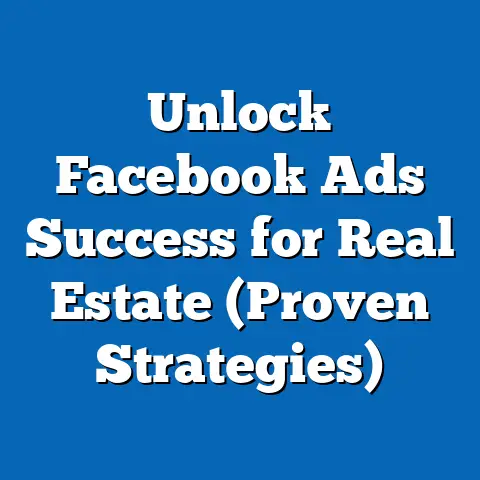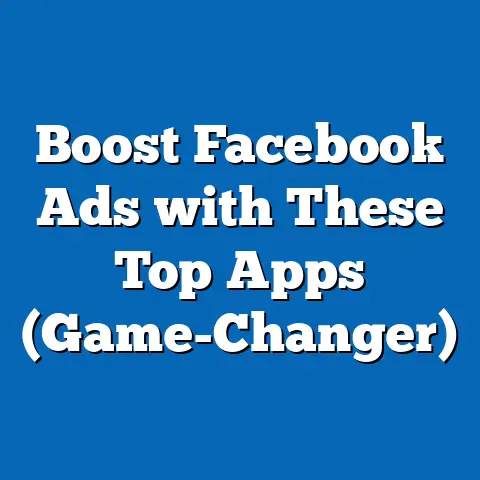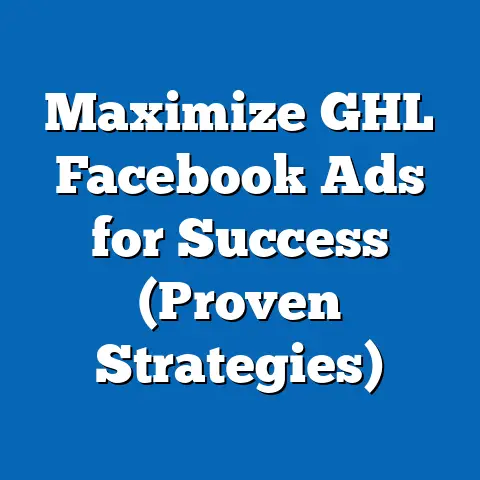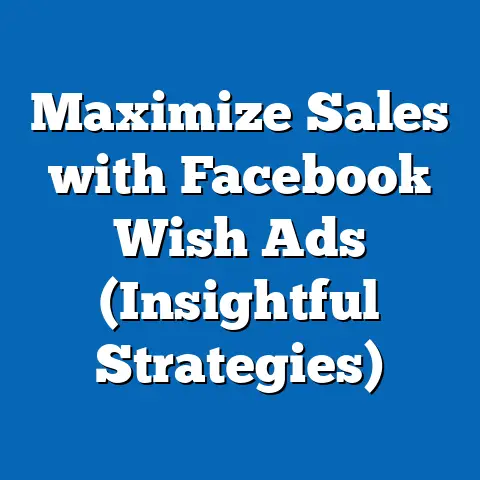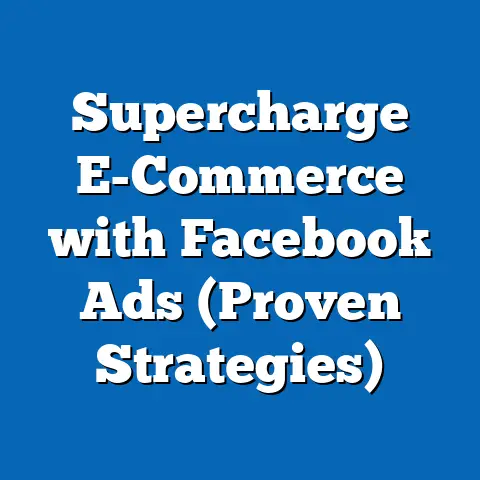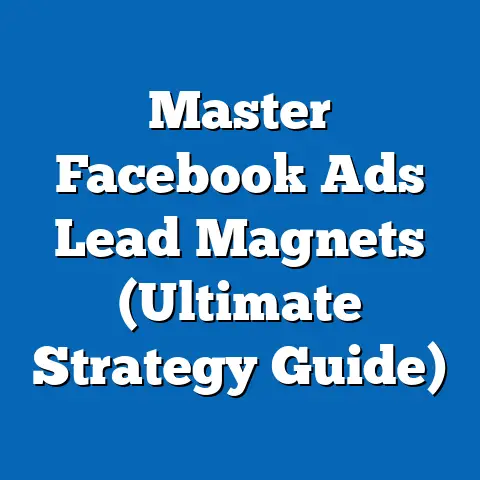Unlock Data Studio with Facebook Ads Connector (Game-Changer)
In the ever-evolving world of digital marketing, standing still is akin to moving backwards. Innovation isn’t just a buzzword; it’s the lifeblood that keeps us ahead of the curve, especially when it comes to data analytics and advertising. I’ve seen firsthand how quickly the landscape can change, and the marketers who thrive are those who embrace new technologies and methodologies. Gone are the days of gut feelings and intuition; today, data reigns supreme.
The transformation we’ve witnessed over the past decade is nothing short of remarkable. We’ve moved from rudimentary spreadsheets to sophisticated dashboards that offer real-time insights. This shift has made it imperative to harness real-time data to drive our marketing strategies and, ultimately, improve our return on investment (ROI). After all, every click, every impression, and every conversion holds a piece of the puzzle.
Understanding the Facebook Ads Connector
Definition and Overview
So, what exactly is the Facebook Ads Connector? Simply put, it’s a tool that allows you to seamlessly integrate your Facebook Ads data with Google Data Studio. It acts as a bridge, pulling all the relevant metrics and dimensions from your ad campaigns and making them available for analysis within the Data Studio environment. Think of it as a translator, converting complex data sets into a language you can easily understand and act upon.
Purpose and Functionality
Key Features
The Facebook Ads Connector boasts a range of features designed to streamline your data analysis process:
- Customizable Reports: You’re not stuck with pre-defined templates. You have the freedom to create reports tailored to your specific needs, focusing on the metrics and dimensions that matter most to your business.
- Real-Time Data Access: Say goodbye to outdated reports. The connector provides access to real-time data, allowing you to monitor your campaign performance as it unfolds and make adjustments on the fly.
- User-Friendly Interface: Even if you’re not a data scientist, you’ll find the connector easy to use. The intuitive interface makes it simple to connect accounts, select metrics, and create visualizations.
I remember a time when pulling data from Facebook Ads felt like pulling teeth. I had to manually export spreadsheets, clean the data, and then painstakingly create charts and graphs. The Facebook Ads Connector changed all of that. It automated the entire process, saving me countless hours and allowing me to focus on what really matters: analyzing the data and making strategic decisions.
Importance in the Current Marketing Landscape
In today’s marketing landscape, data-driven decision-making is no longer a luxury; it’s a necessity. With the proliferation of data sources and the increasing complexity of marketing campaigns, it’s more important than ever to have access to accurate, timely, and actionable insights. The Facebook Ads Connector plays a crucial role in this context. By providing a seamless way to integrate Facebook Ads data with Google Data Studio, it empowers marketers to:
- Gain a Holistic View of Campaign Performance: By combining Facebook Ads data with other data sources (like Google Analytics), you can get a complete picture of your marketing efforts across all channels.
- Identify Trends and Patterns: Visualizing your data in Data Studio makes it easier to spot trends and patterns that might otherwise go unnoticed.
- Optimize Campaigns for Maximum ROI: By understanding what’s working and what’s not, you can optimize your campaigns in real-time to maximize your return on investment.
Key Takeaway: The Facebook Ads Connector is a powerful tool that bridges the gap between your Facebook Ads data and Google Data Studio, enabling you to visualize, analyze, and optimize your campaigns with ease.
How the Facebook Ads Connector Transforms Data Analysis
Enhanced Data Visualization
One of the most significant advantages of using the Facebook Ads Connector is its ability to create visually appealing dashboards. Let’s be honest, staring at rows and columns of numbers in a spreadsheet can be incredibly tedious and overwhelming. Data Studio allows you to transform that raw data into engaging charts, graphs, and tables that tell a story at a glance.
- Charts: Visualize trends over time, compare performance across different campaigns, and identify outliers.
- Graphs: Illustrate relationships between different metrics, such as spend versus conversions or impressions versus clicks.
- Tables: Display detailed data in a structured format, allowing you to drill down into specific campaigns, ad sets, or ads.
I’ve personally found that presenting data in a visual format makes it much easier to communicate insights to stakeholders. Instead of bombarding them with numbers, you can show them a compelling chart that clearly illustrates the impact of your marketing efforts.
Real-Time Reporting
In the fast-paced world of digital marketing, time is of the essence. Waiting days or weeks for reports is simply not an option. The Facebook Ads Connector provides access to real-time data, allowing you to monitor your campaign performance as it unfolds. This means you can:
- Identify and Address Issues Immediately: If you notice a sudden drop in performance, you can quickly investigate the cause and take corrective action.
- Capitalize on Emerging Opportunities: If you see a particular ad or ad set performing exceptionally well, you can increase your budget and scale your campaign accordingly.
- Make Data-Driven Decisions in Real-Time: No more relying on outdated information. You can make informed decisions based on the most current data available.
I remember running a campaign for a client where we noticed a significant spike in conversions overnight. Thanks to the real-time reporting capabilities of the Facebook Ads Connector, we were able to quickly identify the ad responsible for the surge and increase our budget, resulting in a substantial increase in overall campaign performance.
Custom Metrics and Dimensions
The Facebook Ads Connector isn’t a one-size-fits-all solution. It allows you to customize metrics and dimensions to tailor reports to your specific needs. This means you can:
- Focus on the Metrics That Matter Most: Instead of being overwhelmed by a sea of data, you can focus on the metrics that are most relevant to your business goals.
- Create Custom Calculations: You can create custom calculations based on existing metrics to gain deeper insights into your campaign performance.
- Segment Data in Meaningful Ways: You can segment your data by various dimensions, such as age, gender, location, or device, to understand how different audiences are responding to your ads.
For instance, if you’re running a campaign to generate leads, you might want to focus on metrics like cost per lead (CPL) and lead conversion rate. You can create custom calculations to track these metrics and segment your data by different demographics to identify your most valuable lead sources.
Comparison with Traditional Reporting Methods
The Facebook Ads Connector offers a significant advantage over traditional reporting methods, which often involve manual data extraction and analysis. Let’s compare the two approaches:
| Feature | Facebook Ads Connector | Traditional Reporting Methods |
|---|---|---|
| Data Extraction | Automated | Manual |
| Reporting Frequency | Real-time | Periodic (e.g., weekly, monthly) |
| Data Visualization | Interactive dashboards with customizable charts/graphs | Static spreadsheets with limited visualizations |
| Efficiency | Highly efficient | Time-consuming and labor-intensive |
| Accuracy | High (minimal risk of human error) | Lower (risk of human error during data entry) |
| Feature | Facebook Ads Connector | Traditional Reporting Methods |
|---|---|---|
| Data Extraction | Automated | Manual |
| Reporting Frequency | Real-time | Periodic (e.g., weekly, monthly) |
| Data Visualization | Interactive dashboards with customizable charts/graphs | Static spreadsheets with limited visualizations |
| Efficiency | Highly efficient | Time-consuming and labor-intensive |
| Accuracy | High (minimal risk of human error) | Lower (risk of human error during data entry) |
Key Takeaway: The Facebook Ads Connector transforms data analysis by providing enhanced data visualization, real-time reporting, customizable metrics, and increased efficiency compared to traditional reporting methods.
Step-by-Step Guide to Setting Up the Facebook Ads Connector
Now that you understand the benefits of the Facebook Ads Connector, let’s walk through the process of setting it up and creating your first report.
Prerequisites
Before you get started, make sure you have the following:
- Google Data Studio Account: You’ll need a Google account to access Data Studio. If you don’t already have one, you can create one for free.
- Facebook Ads Account: You’ll need a Facebook Ads account with active campaigns to connect to Data Studio.
- Appropriate Permissions: Ensure you have the necessary permissions to access the Facebook Ads account you want to connect. You’ll typically need to be an admin or advertiser.
Installation Process
The installation process is straightforward. Here’s a step-by-step guide:
- Open Google Data Studio: Go to https://datastudio.google.com/ and log in with your Google account.
- Create a New Report: Click the “+” button in the top-left corner to create a new blank report.
- Add Data Source: In the report editor, click “Add data” in the right-hand panel.
- Search for “Facebook Ads”: In the data source list, search for “Facebook Ads” and select the connector.
- Authorize the Connector: You’ll be prompted to authorize the connector to access your Facebook Ads account. Click “Authorize” and follow the on-screen instructions.
Connecting Accounts
After authorizing the connector, you’ll need to connect your Facebook Ads account:
- Select Your Facebook Ads Account: Choose the Facebook Ads account you want to connect from the dropdown menu.
- Select Your Currency: Choose the currency you want to use for your reports.
- Click “Connect”: Click the “Connect” button to establish the connection between your Facebook Ads account and Data Studio.
Creating Your First Report
Now that you’ve connected your accounts, you can start creating your first report:
- Choose a Template (Optional): Data Studio offers a variety of pre-built templates that you can use as a starting point. If you prefer, you can start with a blank canvas.
- Add Charts and Graphs: In the report editor, click “Add a chart” to insert a chart or graph.
- Select Your Data Source: Choose the Facebook Ads data source you just connected.
- Choose Your Chart Type: Select the type of chart or graph you want to use (e.g., time series, bar chart, pie chart).
- Configure Your Dimensions and Metrics: Drag and drop dimensions and metrics from the available fields to configure your chart. For example, you might want to display the number of impressions over time, or the cost per click for different ad sets.
- Customize Your Report: Use the formatting options to customize the appearance of your report, including colors, fonts, and chart labels.
Common Pitfalls and Troubleshooting Tips
While the setup process is generally straightforward, you might encounter a few common issues:
- Authorization Errors: Make sure you have the necessary permissions to access the Facebook Ads account you’re trying to connect.
- Data Discrepancies: Double-check that your currency settings are correct and that you’re using the same timezone in both Facebook Ads and Data Studio.
- Slow Data Loading: If you’re dealing with a large amount of data, it might take a while for the connector to load the data. Try filtering your data or using a smaller date range to improve performance.
Key Takeaway: Setting up the Facebook Ads Connector involves installing the connector, connecting your Facebook Ads account, and creating your first report by adding charts and graphs and configuring dimensions and metrics. Be aware of common pitfalls and troubleshooting tips to ensure a smooth setup process.
Case Studies and Success Stories
The Facebook Ads Connector isn’t just a theoretical tool; it’s been proven to deliver real results for businesses of all sizes. Let’s take a look at some case studies and success stories.
Real-World Applications
- E-Commerce Business: An e-commerce business used the Facebook Ads Connector to track the performance of its product ads. By visualizing the data in Data Studio, they were able to identify underperforming ads and optimize their targeting, resulting in a 20% increase in sales.
- Lead Generation Agency: A lead generation agency used the connector to monitor the cost per lead for its clients’ campaigns. By segmenting the data by different demographics and interests, they were able to identify the most profitable audiences and focus their efforts accordingly.
- Local Restaurant: A local restaurant used the connector to track the effectiveness of its Facebook Ads in driving foot traffic. By visualizing the data in Data Studio, they were able to identify the ads that were generating the most reservations and optimize their ad spend accordingly.
Quantifiable Results
- Increased Engagement: One company reported a 30% increase in engagement after using the Facebook Ads Connector to optimize its ad creatives.
- Improved ROI: Another company saw a 15% improvement in ROI after using the connector to refine its targeting strategy.
- Reduced Costs: A third company was able to reduce its cost per acquisition by 10% after using the connector to identify and eliminate underperforming ads.
These are just a few examples of the tangible benefits that businesses have achieved by using the Facebook Ads Connector.
Testimonials
“The Facebook Ads Connector has been a game-changer for our marketing team. We can now visualize our data in a way that’s easy to understand and share with stakeholders. It’s saved us countless hours and has helped us make more informed decisions.” – Marketing Manager, Tech Startup
“We were struggling to track the performance of our Facebook Ads campaigns. The Facebook Ads Connector made it easy to pull our data into Data Studio and create insightful dashboards. We’ve seen a significant improvement in our ROI since implementing this tool.” – CEO, E-Commerce Business
Key Takeaway: Real-world applications, quantifiable results, and testimonials demonstrate that the Facebook Ads Connector can significantly enhance marketing efforts by improving campaign performance, increasing engagement, and maximizing ROI.
Future Implications of Data Integration in Marketing
As we look ahead, it’s clear that data integration will play an even more critical role in the future of marketing. The ability to seamlessly connect different data sources and visualize the information in a meaningful way will be essential for success.
Trends in Data-Driven Marketing
- Increased Focus on Personalization: Marketers will increasingly use data to personalize their messaging and target their ads to specific individuals.
- Greater Reliance on Predictive Analytics: Marketers will use data to predict future trends and behaviors, allowing them to proactively adjust their strategies.
- More Sophisticated Attribution Models: Marketers will use data to better understand the customer journey and attribute conversions to the appropriate touchpoints.
The Role of AI and Automation
Artificial intelligence (AI) and automation will play a significant role in the evolution of tools like the Facebook Ads Connector. We can expect to see:
- AI-Powered Insights: AI algorithms will automatically analyze data and provide actionable insights, helping marketers to identify opportunities and optimize their campaigns.
- Automated Reporting: AI will automate the creation of reports, freeing up marketers to focus on more strategic tasks.
- Intelligent Optimization: AI will automatically adjust ad bids, targeting, and creatives based on real-time data, maximizing campaign performance.
Conclusion
The Facebook Ads Connector is a prime example of how innovation can empower marketers to make data-driven decisions that enhance their advertising strategies. As we move forward, we can expect to see even more sophisticated tools that leverage AI and automation to provide deeper insights and optimize campaign performance. Embracing these tools and staying ahead of the curve will be essential for success in the ever-evolving world of digital marketing.
Key Takeaway: The future of marketing will rely heavily on data integration, personalized experiences, predictive analytics, and the use of AI and automation to enhance marketing analytics and strategies.
The Facebook Ads Connector is more than just a convenience; it’s a strategic asset that empowers you to make data-driven decisions, optimize your campaigns in real-time, and ultimately, achieve better results. By visualizing your data in Data Studio, you can gain a deeper understanding of your audience, identify trends and patterns, and personalize your messaging for maximum impact.
As we look to the future, it’s clear that data analytics will continue to play an increasingly important role in marketing. Tools like the Facebook Ads Connector will become even more sophisticated, leveraging AI and automation to provide deeper insights and streamline the reporting process.
I encourage you to explore the Facebook Ads Connector for yourself and experience the transformative power of data-driven marketing. Connect your Facebook Ads account to Data Studio, experiment with different charts and graphs, and discover the insights that are waiting to be uncovered. The future of marketing is data-driven, and the Facebook Ads Connector is your key to unlocking that future.

